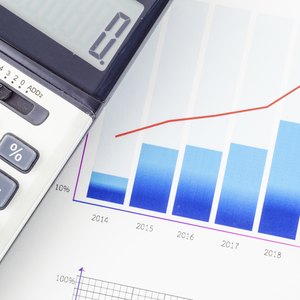
It is not enough for an investment to be profitable. Investors want to know how much they are likely to make. There’s good reason for this approach: Stocks carry risk. Before you put your money into a company’s stock, it’s important to know if the probable return justifies the risk. Market value added and economic value added are measures of manage performance that may help you decide if a particular company’s stock is a good bet.
Meaning of Market Value Added
Market value added is simply the difference between the total market value of a company and the book value of capital invested. To figure market value, multiply the number of common shares outstanding by the price per share. Do the same for preferred stock. Add the amounts for common and preferred stock together to calculate market value. Subtract the book value of capital invested to get the MVA. Suppose a firm has 1.5 million common shares outstanding selling at $10 and 250,000 preferred shares at $20. The market value comes to $20 million. If the firm’s capital equity invested equals $12 million, you have an MVA of $8 million.
MVA Pros and Cons
Market value added can indicate strong management performance. Plus, this is a simple measure to figure. You only need current stock quotes and information found on a company’s balance sheet. However, MVA doesn’t factor in cash payouts to investors such as dividends. Market factors may influence the MVA figure, reducing its usefulness as a management performance indicator. For instance, a company may not be doing as well as a high MVA would suggest if the stock has benefited from an overall bull market.
Description of Economic Value Added
Economic value added is a performance measure developed and trademarked by Stern Stewart & Co. EVA is equal to a company’s net profit minus the cost of capital. Net profit for EVA is the net operating profit excluding unusual earnings. Cost of capital, formally called weighted average cost of capital, is the percentage a firm must pay for the use of money provided by investors. The percentage cost of capital is multiplied by the capital invested to convert it to a dollar figure. Suppose a company has capital invested amounting to $15 million and an 8 percent cost of capital. Multiply these figures to get a dollar figure for the cost of capital of $1.2 million. If the net profit is $2.5 million, subtracting the $1.2 million cost of capital leaves an economic value added of $1.3 million (Reference 3)
Significance of Economic Value Added
Suppose a company’s net operating profit is sufficient to cover the cost of capital but no more. For the investor, this isn’t very attractive, because she can probably find investments such as bonds or bank certificates of deposit that will earn as much with less risk. The concept of economic value added is based on the notion that an investor should look for a return sufficiently greater than the cost of capital to justify added risk. EVA tells the investor how much the company is making over and above the cost of capital, if anything. Calculating EVA is more complicated than figuring market value added, but it has the advantage of being independent of market forces that has no bearing on company performance.
References
Writer Bio
Based in Atlanta, Georgia, W D Adkins has been writing professionally since 2008. He writes about business, personal finance and careers. Adkins holds master's degrees in history and sociology from Georgia State University. He became a member of the Society of Professional Journalists in 2009.

